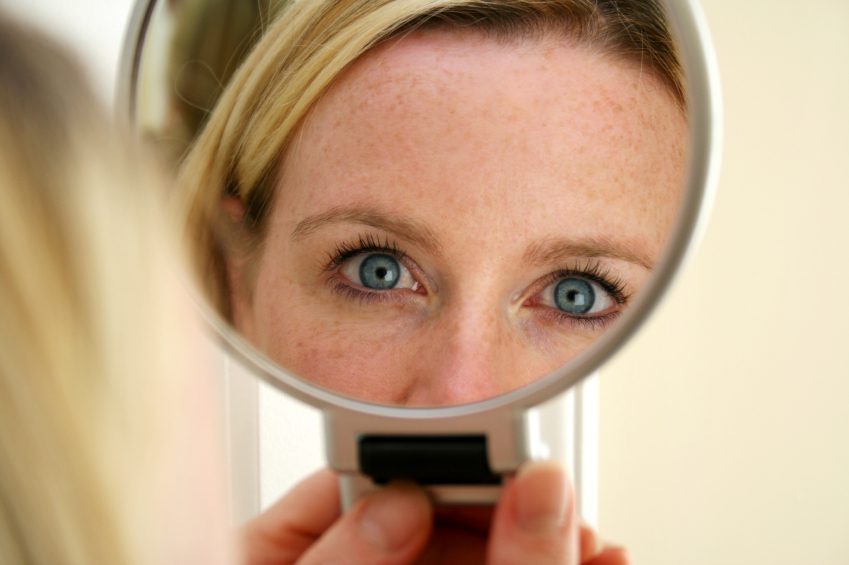Self-Awareness as the Foundation of Emotional Intelligence

It’s easy to skip right over this. To check the box. Of course you’re self-aware, right?
So I’m just gonna say it: you’re not as self-aware as you think you are. Neither am I. No one is. Our brains are wired that way.
Self-awareness is naturally, evolutionarily, limited unless you develop it. It is a skill we learn through practice. This is vital for the change-making leader because self-awareness is required for making purposeful change.
Two Avenues of Self Awareness
One type of self-awareness, conceptual self-awareness, is “Self thinking about itself.” It’s what we know or how we identify ourselves. It includes biographical information, details and memories, and the story we’ve assembled about our life. This is where many forms of thought-based coaching and therapy can have some impact.
The other type, embodied self-awareness, is “Self experiencing itself.” This information is received through sensory awareness. It can come to us from outside ourselves—exteroception—via the five senses. The brain allocates a lot of space and energy to receiving these inputs because awareness of our surroundings is linked to our survival. We can experience this sensory information (sight, sound, touch, smell, and taste) in varying degrees of consciousness which we can control.
In addition to external sensory information, the brain is also always receiving sensory information from the internal state of the body (interoception). Brainstem function supports the body in maintaining homeostasis (thirst, blood pressure, etc) by constant micro-level neurological and biochemical adjustments that occur below awareness. Simultaneously, the limbic system is evaluating sensations as good or bad, resulting in emotions that incite action, often without our conscious awareness.
One other source of interoceptive sensory information includes the body’s position in space (proprioception): how your body and limbs “know” where they are. Something as mindless as touching finger to nose with eyes closed is achieved by a highly sophisticated system, operating beneath conscious awareness. When activated by touch (self or other), signals sent to the brain get translated to muscle spindles which use minute contractions or stretching to position the body. This is how you can swat a mosquito on your arm without even knowing it.
Here’s what this means to you: a whole realm of sensory information is stirring up emotion and driving you to action without your conscious awareness or active choice! Interoception and proprioception, combined, are constantly eliciting emotions that you then acting upon without knowing it.
What value would it bring you to become more aware of what’s going on inside before it becomes unconscious action? Consider the power of changing your automatic, unconscious, response to certain people, triggering situations, engrained beliefs, perceived limitations…the possibilities are endless. And it begins with increasing embodied self-awareness.
Conceptual self-awareness is important but limiting. On the other hand, embodied self-awareness activates different parts of brain than those activated by conceptual self-awareness. When Self experiences itself, it gains an entire new realm of information and possibility far beyond Self knowing itself. Embodied self-awareness increases conscious awareness of these three forms of sensory information–exteroception, interoception and proprioception—to more fully inform your choice of action.
Whole-Self Self-Awareness
Embodiment is a fundamental aspect of self-awareness. Embodied self-awareness and conceptual self-awareness happen on different neural pathways, making embodiment essential for true present-moment awareness.
You’ve probably experienced embodied self-awareness. You may remember it as feeling almost overwhelmed by the activation of your entire sensory network: body sensation, emotion, urge to act, and, most especially, emotional significance. These rich, heart-swelling moments are often called peak emotional experiences. The conceptual self shrinks. We report feeling “so small” when present to this magnificent, expansive reality. You were plugged in—your senses, emotions and actions were synced at a cellular level—and you felt your whole self in that moment.
When embodied information is accessed consciously, it offers a massive amount of information that can be used to better inform choices toward your desired experiences and outcomes. With intentional practice, embodied information can be accessed more and more readily, eventually replacing your default programming which simply, automatically, replays past experiences.
The development of beneficial new neural networks is possible but requires focused, sustained effort to overcome inherent challenges. First, to support our evolutionary survival, the body is biased toward external sensory information. Second, our culture favors and rewards intellectual (self-conceptual) data, while ignoring or even disparaging embodied wisdom. And, finally, we each have psychobiological armoring that distorts or limits our embodied sensing.
How can a change-making leader unlock this massive realm of information? Begin with the practice of feeling more.
Making Real Change
It’s just as easy—actually, it’s easier—to reinforce existing neural networks than it is to build new ones. It’s how we’re wired (ha ha…a little neuroscience humor). Without coaching—or even with forms of coaching that only focus on Self—even the most well-intended leader can work against themselves by reinforcing concepts of Self that keep you stuck. Focusing only on conceptual self-knowledge—my strengths, my enneagram, my Myers-Briggs, etc.—can fortify and strengthen the neural networks associated with that identity, locking us into the associated mindset and behaviors.
You can’t think yourself into real change. Because your responses are neurologically wired-in at a level below your consciousness, you must engage and enlist all parts of yourself toward becoming conscious of, and then replacing, the undesired thoughts, beliefs and automatic actions that have literally shaped you.
How do we build new neural networks that support ready access to embodied self-awareness? The place to begin is with practices that take you out of your head and into your body…that’s why it’s called embodiment 😊 Here are a few:
- Deep breathing
- Hypnosis
- Intuition practices
- Meditation
- Mindfulness
- Touch Therapies
- Visualization
Don’t underestimate the power—the absolute essentialness—of putting into place a regular practice that battles and eventually breaks your wired-in thought patterns, creating tiny gaps into which you can insert your behavior-change crowbar. “Practice” is the key word, here. Practice is something done regularly. Practice strengthens. Practice—bad or good, easy or hard—builds your capacity for real-life challenges. What these embodied practices reveal to you IS the embodied self-awareness you need to bring real change. Start there.
Then, continue to my post How to Develop Embodied Self-Awareness.
[References and Resources: Amanda Blake, Body=Brain; Daniel Goleman, Emotional Intelligence; Bud Craig’s works on interoception]

Leave a Reply